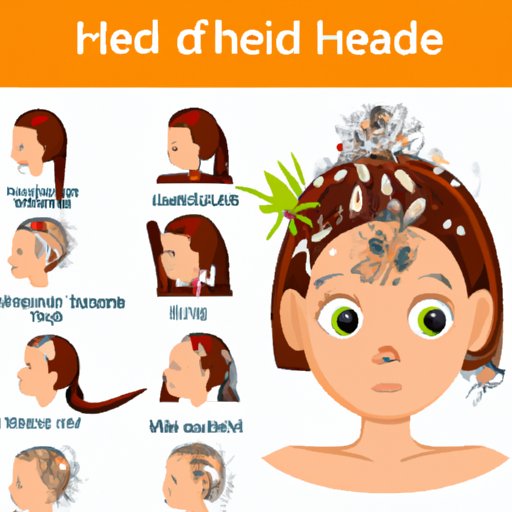Introduction
Head lice infestations are a common problem, affecting millions of people each year, both children, and adults. These tiny parasites feed on human blood and thrive in hair, causing itching, discomfort, and embarrassment. While head lice are not dangerous, they can be hard to eliminate. The purpose of this article is to provide readers with a better understanding of head lice, how they spread, and effective ways to deal with them. Whether you are a parent, an educator, or an individual dealing with head lice, this article has everything you need to know to prevent and treat infestations.
Causes of Head Lice Infestations
A common misconception about head lice is that they spread through poor hygiene. In reality, anyone can get lice, regardless of their hygiene habits. Head lice are mainly spread through direct contact with infested persons, particularly head-to-head contact, shared personal items like hats, combs, and hairbrushes, and exposure to areas where infestations have recently occurred.
According to the Centers for Disease Control and Prevention (CDC), an estimated 6-12 million cases of head lice occur in the United States annually, most commonly among school-aged children during the school year. Head lice epidemics are often caused by a combination of the above factors, including close proximity among children in classrooms, playgrounds, locker rooms, and sports activities.
How Head Lice Spread in Schools
Schools are common areas for head lice infestations due to the close contact among students. Lice can easily spread by sharing personal items such as hats, combs, and headphones or by simply playing and touching heads during group activities or sports. Although lice cannot jump or fly, they can crawl quickly from one person to another.
Preventing head lice outbreaks in schools is crucial. Parents and educators can teach children good hygiene practices that can help to prevent the spread of lice. They can also discourage sharing personal items and encourage children to keep their belongings separate from others. Regular head checks by parents and school nurses can help detect infestations early and prevent them from spreading.
The Life Cycle of Head Lice
Understanding the life cycle of head lice can help in treating and preventing infestations. Head lice have a lifespan of about 30 days and undergo three stages of development: eggs (nits), nymphs, and adults. Female lice lay eggs that are glued to the hair close to the scalp and typically hatch in 7-10 days. Once hatched, the nymphs molt three times before reaching adulthood, which can take up to 10 days. Adult lice can live up to 30 days and continue to lay eggs throughout their lifespan.
Nits are often mistaken for dandruff but can be easily distinguished as they are glued to the hair shaft and cannot be brushed off. Nymphs and adult lice are around the size of a sesame seed and have six legs. Head lice are usually found on the scalp and neck area, but they can also be present on the eyebrows, eyelashes, and beard area in rare cases.
Identifying Head Lice
Identifying head lice can be tricky as they are tiny and not always visible to the naked eye. The most common symptom of head lice is itching, but not everyone experiences this symptom. Other signs to look out for include red bumps or small sores on the scalp, neck, and shoulders. In severe cases, people may also experience fatigue, irritability, and difficulty sleeping.
The best way to identify head lice is by using a fine-toothed comb, also known as a lice comb. Combing the hair in sections over a white towel or paper can help to spot lice or nits. Another effective method is shining a bright light, such as a flashlight, on the scalp to spot any lice or nits moving around.
Treating Head Lice
Dealing with head lice can be frustrating, but there are effective treatments available. Over-the-counter remedies containing pesticides such as permethrin or pyrethrin are commonly used. Prescription medications, such as ivermectin or malathion, can also be used in severe cases. However, some head lice have become resistant to these treatments, and there can be side effects.
Natural remedies such as tea tree oil, neem oil, and olive oil have also been found to be effective in treating head lice. These remedies are less toxic than chemical treatments and can be used in conjunction with a lice comb. Applying mayonnaise or petroleum jelly to the hair overnight and combing out the lice and nits have also been found to be effective home remedies.
To prevent future head lice infestations, it is important to maintain good hygiene habits, such as washing hair regularly and avoiding the sharing of personal items. Clothing, beddings, and other shared items should be washed in hot water, and combs and brushes should be soaked in hot water for at least 10 minutes. Regular head checks should also be performed to detect infestations early and prevent them from spreading.
Conclusion
Head lice infestations can occur to anyone, but there are effective ways to deal with them. Understanding how head lice spread, how to identify them, and effective treatment options is crucial in combating infestations. Maintaining good hygiene habits, avoiding head-to-head contact, and taking necessary precautions to prevent lice from spreading can help prevent future outbreaks. Remember, it’s crucial to stay vigilant in checking for lice and taking the appropriate steps to eliminate them.
We hope this article has provided you with valuable information on head lice, and you are now better equipped to deal with infestations. If you have any questions or experiences to share, please do so in the comments.
